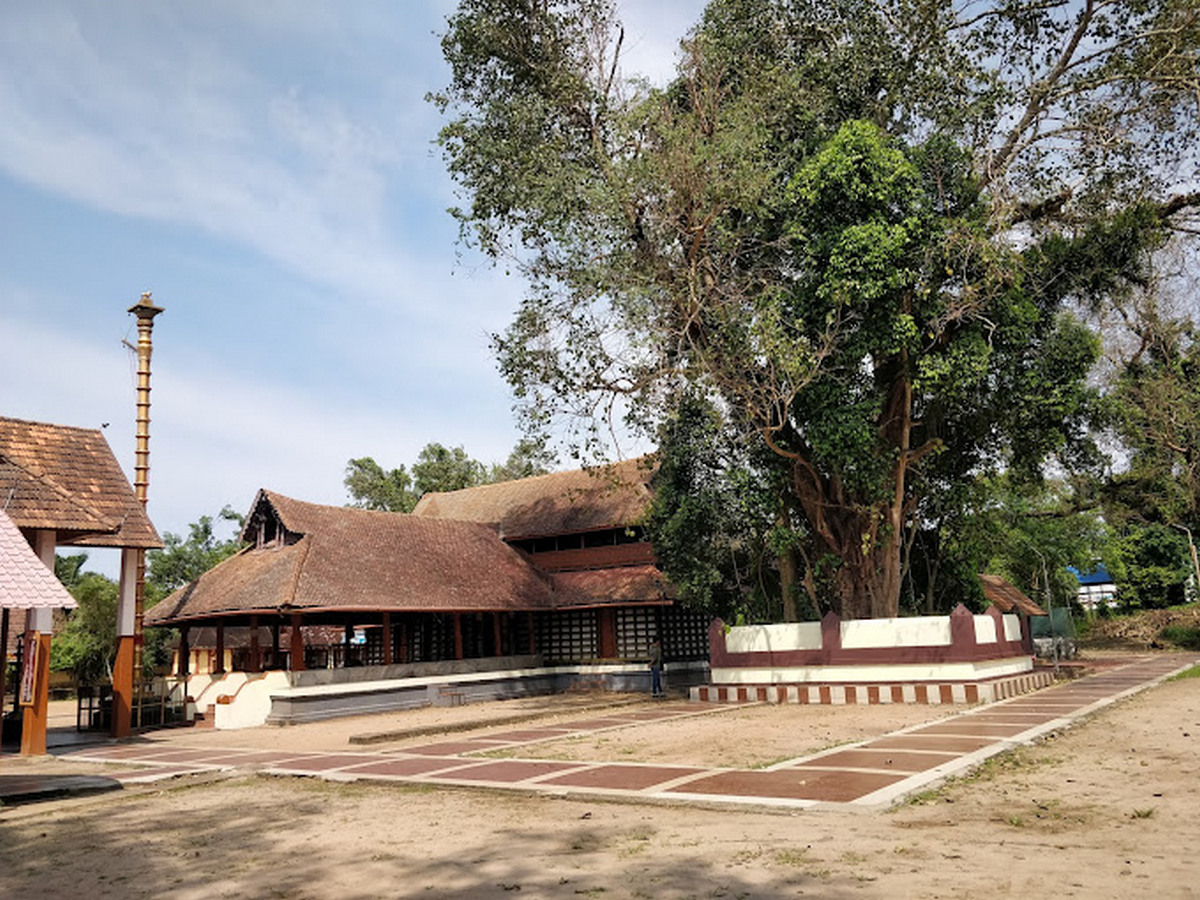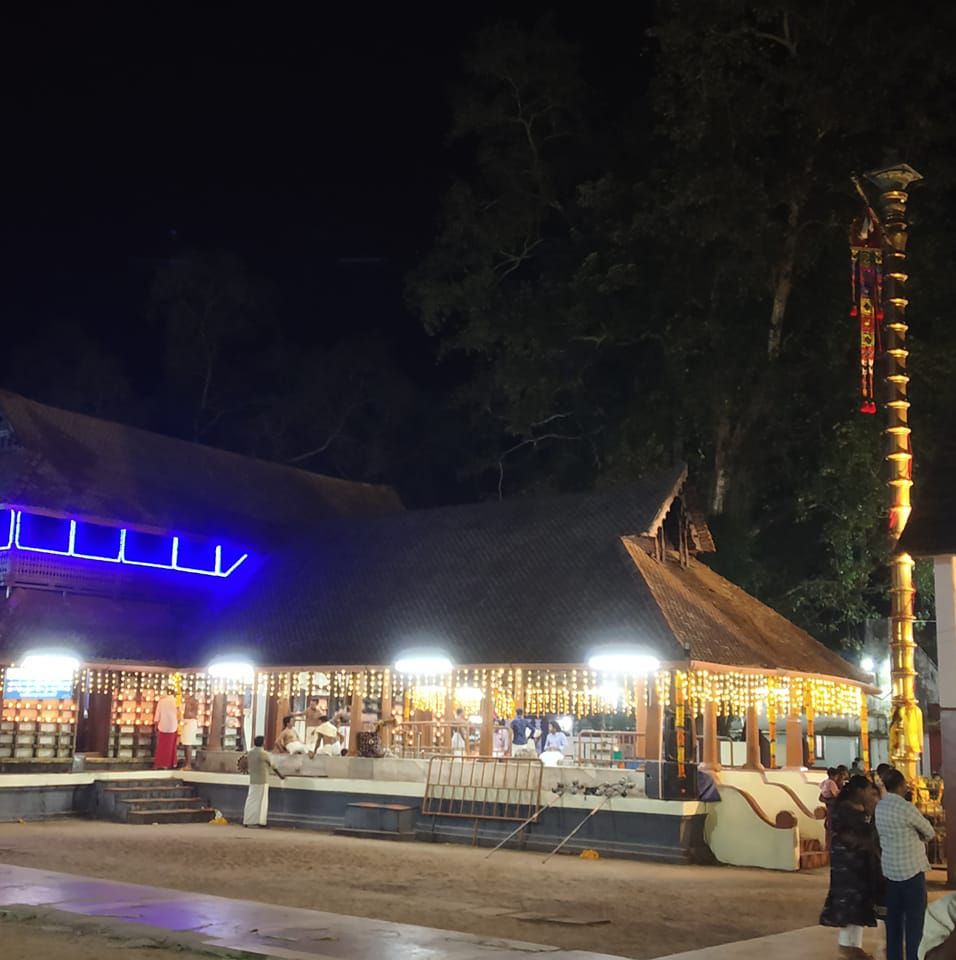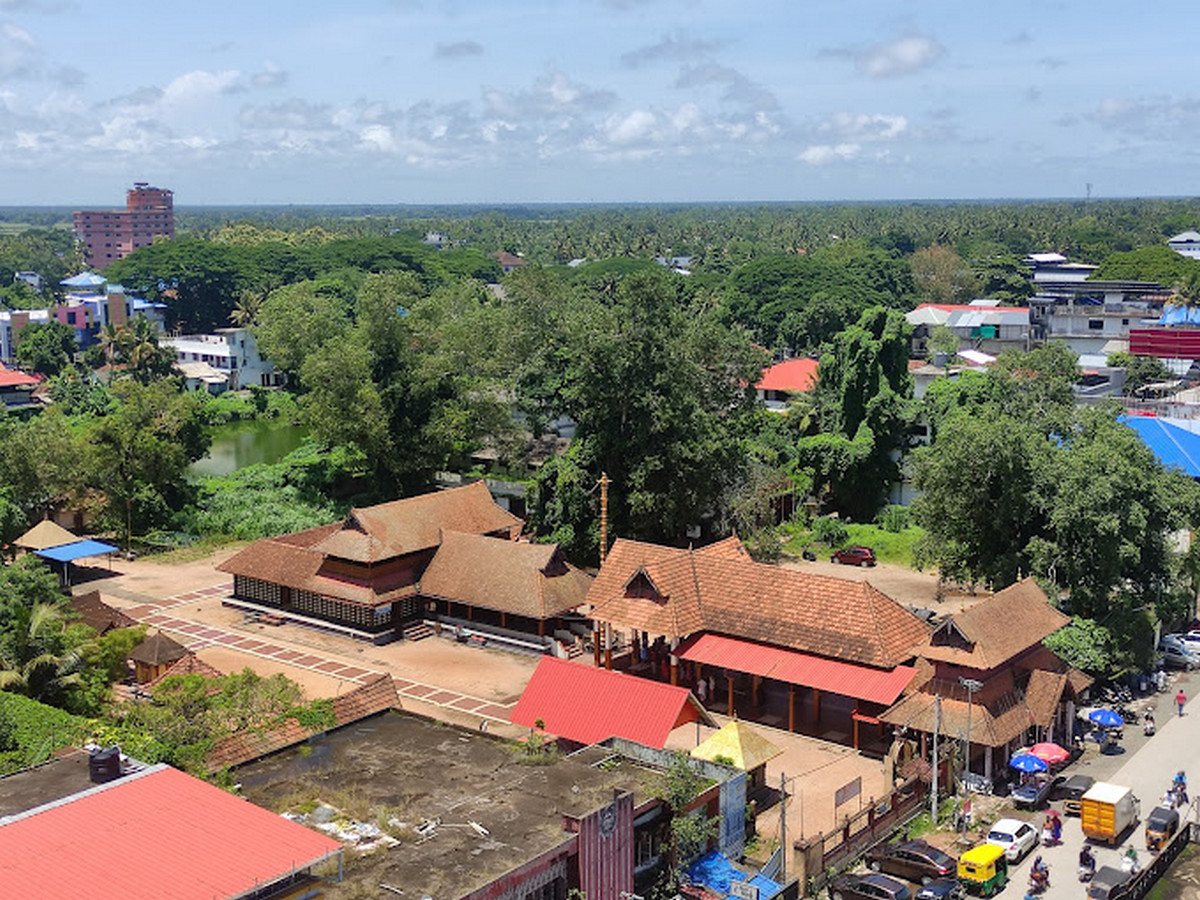Mullakkal Rajarajeswari Temple, situated in the heart of Mullakkal, Alappuzha, Kerala, is a renowned Hindu temple dedicated to Goddess Durga.

The temple is run by the Travancore Devaswom Board. The sanctum sanctorum of the Mullakkal Rajarajeswari Temple features a unique open roof design. In addition to the presiding deity, Goddess Durga, the temple enshrines other deities, including Hanuman, Ganesha, Subramanya, Nagaraja, Navagraha, Krishna, and Ayyappa.
A sacred banyan tree within the temple complex also houses a Shiva Lingam at its base, adding to the temple's spiritual significance. The Mullakkal Rajarajeswari Temple is believed to be nearly 500 years old, with multiple legends surrounding its origin. According to one story, exiled soldiers from Thekkumkur territory brought the goddess's idol and placed it in a jasmine garden. Later, King Devanarayana of Chembagasery constructed a temple at the site. Another legend narrates that King Devanarayana, after seeing the goddess at the Kodungalloor Bhagavathy Temple, wished to bring her to his kingdom.
The goddess appeared in his dream, agreeing to accompany him. While resting in a jasmine garden in Alappuzha, the king found his umbrella immovable, interpreting it as a divine sign that the goddess desired to remain there, prompting him to build the temple.
A third popular tale connects the temple's origins to the Mysore conquest of Kerala by Tippu Sultan. Fleeing Namboodiri Brahmins carried the idol of Annapurneswari from Malabar and placed it in a jasmine garden, building a shrine there, which eventually became the temple.
Originally, the inner sanctum housed the idol of Annapurneswari, depicted with a ladle in one hand and a pot in the other.
However, in 1961, a mysterious event led to the replacement of the idol. After a stranger embraced the idol, cracks appeared, interpreted as the goddess's instruction to create a new idol. On 16 July 1962, a new idol of Rajarajeswari was consecrated, replacing the original. Subsequently, additional idols, including those of Krishna and various serpent gods, were installed in separate shrines within the temple complex. Special foods and sweet delicacies are presented to the goddess as Naivedyam. According to tradition, on the inaugural day of worshipping the Annapurneswari idol, the prasadam included vadas prepared from whole urad dal, which were provided by a local family.
Continuing this tradition, the same prasadam is prepared today, with ingredients contributed by various devotees. This unique prasadam is typically offered during the night. Numerous festivals are linked to the Mullakkal Rajarajeswari Temple, with the most significant being the Mullakkal Chirappu, which spans a duration of forty-one days. This festival begins in the month of Vrishchikam, typically around mid-November, and concludes on the eleventh day of Dhanu, which falls between December and January. The last eleven days of this celebration are specifically designated as the Chirappu festival. The concluding two days of the event are particularly noteworthy and revered.
This occasion attracts thousands of attendees who gather to witness magnificent parades featuring elaborately adorned elephants. The Mullakkal Chirappu is observed at the temple with immense splendor and profound religious devotion. In addition to the regular puja, a variety of cultural programs that showcase Kerala's rich heritage are integral to the festivities. Furthermore, the event includes 'Annadanam,' where a grand feast is provided on the final day, catering to approximately 3,000 to 4,000 devotees. Renowned musicians and artists are invited to perform at the temple grounds during the evening. The first Sunday of December is observed as a women's festival, where women exclusively perform all rituals, lighting lamps and offering prayers.
The Navarathri festival is another grand occasion. On Maha Navami, baby girls (150–200) are gifted new clothes and revered as divine Kumaris. Rituals like "Theyattu," featuring dancers erasing a powdered portrait of the goddess, and the placing of children's textbooks for pooja in the shrine, are key highlights. The Bommai Kolu Festival, integral to Navarathri, sees elderly women arranging dolls in the temple's 'Oottupura,' reading the Bhagavatham, and offering prayers.
The temple also celebrates Thaipooyakavadi, where around 15 Kavadis participate in parades and traditional dances. In earlier times, elephants adorned with nettipattam were paraded in the evenings, with the deity ceremonially placed on the main elephant and accompanied by chendamelam. These festivals collectively showcase the temple's cultural and religious richness.
മുല്ലക്കൽ രാജരാജേശ്വരി ക്ഷേത്രം
ആലപ്പുഴയുടെ നഗര മധ്യത്തിൽ സ്ഥിതിചെയ്യുന്ന നൂറ്റാണ്ടുകൾ പഴക്കമുള്ള പ്രസിദ്ധമായ ക്ഷേത്രമാണ് മുല്ലക്കൽ രാജരാജേശ്വരി ക്ഷേത്രം. ആലപ്പുഴ റെയിൽവേ സ്റ്റേഷനിൽ നിന്നും 3.5 കിലോമീറ്ററും, KSRTC ബസ് സ്റ്റേഷനിൽ നിന്നും 750 മീറ്ററും ആണ് ക്ഷേത്രത്തിലേക്കുള്ള ദൂരം. മുല്ലപ്പൂവുകൾക്ക് നടുവിലെ ക്ഷേത്രമാണ് മുല്ലക്കൽ ക്ഷേത്രം. മുല്ലക്കൽ എന്ന പേരു വന്നതിനു പിന്നിൽ നിരവധി കഥകളാണ് പ്രചരിക്കുന്നതെങ്കിലും ക്ഷേത്രത്തിനു ചുറ്റും മുല്ലപ്പൂക്കളും ചെടികളും ധാരാളം കാണപ്പെടുന്നതിനാലാണത്രെ ക്ഷേത്രത്തിന് ഈ പേരു ലഭിച്ചത്. ഈ ക്ഷേത്രത്തിന്റെ ഉത്ഭവത്തെക്കുറിച്ച് പല കഥകളും പ്രചരിക്കുന്നുണ്ട്, എന്നാൽ കൃത്യമായ രേഖകളോ സാഹചര്യങ്ങളോ ഇല്ലാത്തതിനാൽ ഇതിലൊന്നുപോലും സ്ഥിരീകരിക്കാൻ സാധിച്ചില്ല.
പതിമൂന്നാം നൂറ്റാണ്ടിനും പതിനാലാം നൂറ്റണ്ടിനും മദ്ധ്യേ സ്ഥാപിതമായ ചെമ്പകശ്ശേരി രാജവംശത്തിന്റെ അധീനതയിലായിരുന്ന തോട്ടപ്പള്ളി കോട്ടാരവളവ് മുതൽ കിടങ്ങുകൾക്ക് തെക്കുവശം (കിടങ്ങാംപറമ്പ്) വരെ താമസിച്ചിരുന്ന ജനവിഭാഗങ്ങൾക്കിടയിൽ ഭൂരിഭാഗവും ബുദ്ധമതവിശ്വാസികളായിരുന്നു. ആദിശങ്കരന്റെ നേതൃത്വത്തിൽ ബുദ്ധമത ക്ഷേത്രങ്ങൾ പിടിച്ചെടുക്കുകയും അതിലൊന്നാണ് മുല്ലക്കൽ ക്ഷേത്രമെന്നും പ്രചാരത്തിലുണ്ട്. കേരളീയ വാസ്തുവിദ്യയിൽ നിർമ്മിച്ചിരിക്കുന്ന മുല്ലക്കൽ ക്ഷേത്രത്തിന്റെ മറ്റൊരു പ്രത്യേകതയാണ് ഇവിടുത്തെ ശ്രീകോവിലിന് മേൽക്കൂര ഇല്ല എന്നുള്ളത്. ക്ഷേത്രത്തിലേക്ക് പ്രവേശിക്കുന്നതിന് സമീപത്തായി ഏകദേശം 20 അടിയോളം സ്ഥലത്ത് മേൽക്കൂര കാണാം.
ആനകൾ ഇവിടെ നിന്നും തിടമ്പേറ്റുന്നതിനാലാണ് ഇത്രയും ഭാഗത്ത് മാത്രം മേൽക്കൂര ഉള്ളത്. തെക്കുംകൂറിൽ നിന്നും നാടുകടത്തപ്പെട്ട സൈനികർ തങ്ങൾ ആരാധിക്കുന്ന ദേവിയുടെ വിഗ്രഹവുമായി ഇവിടെ എത്തിയത്രെ. ഇവിടെ കണ്ട മുല്ലപ്പടർപ്പിനുള്ളിൽ പ്രതിഷ്ഠിച്ച് ആരാധന തുടങ്ങിയ അവർ കാലക്രമത്തിൽ മുല്ലത്തോട്ടത്തിൽ ക്ഷേത്രം നിർമ്മിച്ചു. ചെമ്പകശ്ശേരി ദേവനാരായണ രാജാവിന്റെ കീഴിലായിരുന്നു അന്ന് ഈ ക്ഷേത്രം എന്നും പറയപ്പെടുന്നു. രാജാ മാർത്താണ്ഡവർമ്മയുടെ ഭോജനശാലയായിരുന്നു മുല്ലക്കൽ ക്ഷേത്രം നിൽക്കുന്ന ഇടമെന്നും ഇവിടെ മുല്ലയുടെ ചുവട്ടിൽ കണ്ട ഒരുകല്ലിൽ പ്രതിഷ്ഠാരൂപം ദർശിച്ചുവെന്നും തുടർന്ന് അത് പ്രതിഷ്ഠയാക്കിയെന്നും മറ്റൊരു വിശ്വാസം. ടിപ്പു സുൽത്താന്റെ പടയോട്ടക്കാലത്ത് മലബാറിൽ നിന്നും ഒരു സംഘം ബ്രാഹ്മണർ തങ്ങൾ ആരാധിച്ചിരുന്ന അന്നപൂർണ്ണേശ്വരിയുടെ രൂപവുമായി ഇവിടെ എത്തിയെന്നും പിന്നീട് മുല്ലത്തോട്ടത്തിൽ അവർ ക്ഷേത്രം നിർമ്മിച്ച് ആരാധന തുടങ്ങിയെന്നുമാണ് വേറൊരു ഐതിഹ്യം.
മുല്ലക്കൽ ക്ഷേത്രത്തിന് ചരിത്രകാരന്മാർ പറയുന്നതനുസരിച്ച് ഏകദേശം 500 വർഷത്തോളം പഴക്കമാണുള്ളത്. എന്നാൽ ഇതിന്റെ ഉത്ഭവത്തെക്കുറിച്ച് കേട്ടുകേൾവികൾ മാത്രമാണ് ഉള്ളത്. മാർത്താണ്ഡവർമ്മ രാജാവിന്റെ ഭോജനശാലയായിരുന്ന സ്ഥലമാണ് പിന്നീട് ക്ഷേത്രമായതെന്നും കഥയുണ്ട്. എന്നാൽ ഇതിനെക്കുറിച്ചുള്ള കൃത്യമായ വിവരങ്ങൾ ഇപ്പോഴും ലഭ്യമല്ല. നവരാത്രി, മഹാനവമി, വിജയദശമി, തൈപ്പൂയം തുടങ്ങിയവയാണ് ക്ഷേത്രത്തിലെ പ്രധാന വിശേഷദിവസങ്ങൾ. നഗരമധ്യത്തിലായതിനാൽ ക്ഷേത്രത്തിൽ ധാരാളംപേർ വന്നുപോകുന്നു.
നഗരത്തിലെ പ്രധാന കച്ചവട സ്ഥാപനങ്ങളും ക്ഷേത്ര പരിസരത്തുതന്നെയാണ്. ആലപ്പുഴയുടെ ഉത്സവത്തിൻറെ ലഹരി കാണിച്ചു തരുന്ന ആഘോഷമാണ് മുല്ലക്കൽ ചിറപ്പ്. മുല്ലക്കൽ രാജരാജേശ്വരി ക്ഷേത്രം, കിടങ്ങാംപറമ്പ് ക്ഷേത്രം എന്നിവിടങ്ങളിടെ ഉത്സവവുമായി ബന്ധപ്പെട്ടു നടക്കുന്ന വ്യാപാരമേളയാണ് മുല്ലക്കൽ ചിറപ്പ് എന്നറിയപ്പെടുന്നത്. വൃശ്ചികം ഒന്നു മുതൽ 41 ദിവസമാണ് മുല്ലക്കൽ ചിറപ്പ് നടക്കുക. ഡിസംബർ മാസത്തിലെ ആദ്യ ഞായറാഴ്ചയിലെ ചിറപ്പിന് നേതൃത്വം നല്കുന്നത് സ്ത്രീകൾ മാത്രമാണെന്ന പ്രത്യേകതയും ഉണ്ട്.
Address:
Rajeswari Temple,
Mullakkal,
Alappuzha, Kerala 688009



